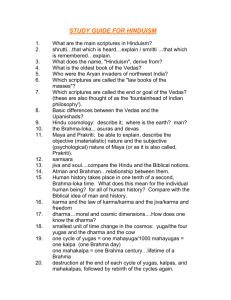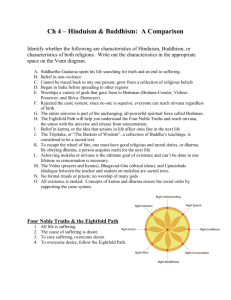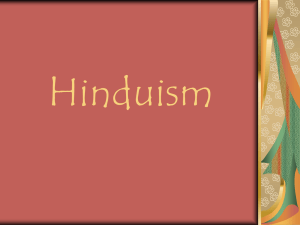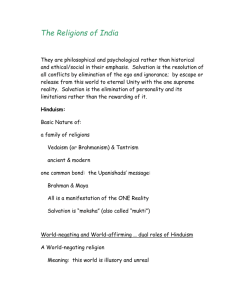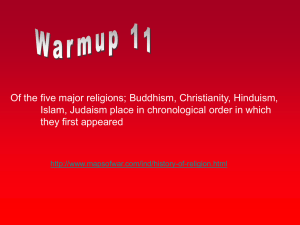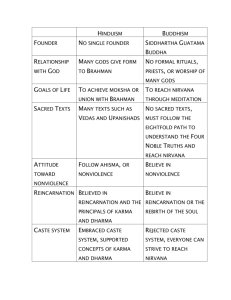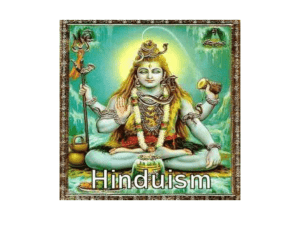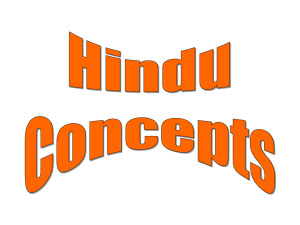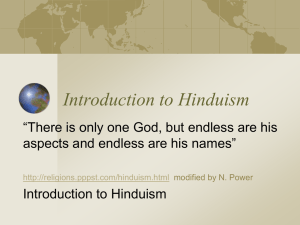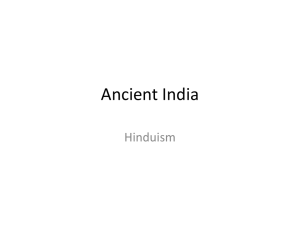Hinduism: Key Concepts & Beliefs Worksheet
advertisement
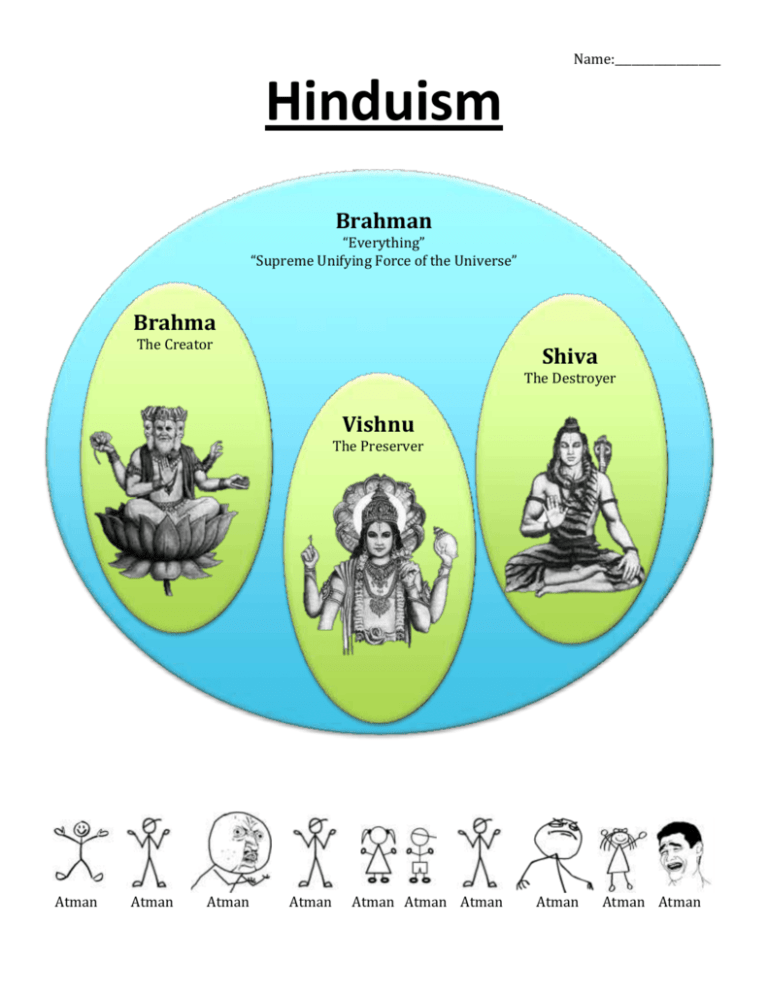
Name:___________________ Hinduism Brahman “Everything” “Supreme Unifying Force of the Universe” Brahma The Creator Shiva The Destroyer Vishnu The Preserver Atman Atman Atman Atman Atman Atman Atman Atman Atman Atman Rebirth Life Samsara (Cycle of Reincarnation) Death Dharma Karma Moksha (Duty) (Action & Reaction) (Escaping Samsara) - One’s place in society - One’s duty - One’s path -What goes around comes around -By following Dharma, one “builds up” good Karma -Attaining “Heaven” -Escape from the cycle of life, death, rebirth, life, death, rebirth, etc. -Consequence -Becoming one with Brahman -Determines one’s social position in the next life -Ultimate Goal of Hinduism What do Hindus Believe? According to Hinduism, there is a great, single unifying force in the Universe known as Brahman. To more easily understand the concept of Brahman, Hindus have conceptualized Brahman into three main gods: Brahma (The Creator), Vishnu (The Preserver), and Shiva (The Destroyer). A rich and complex pantheon of thousands of gods has developed over thousands of years. These gods, however, are not separate. They simply represent the many aspects of Brahman. While many Hindus worship individual gods and goddesses, it is believed that everything in the Universe is part of Brahman: People, trees, animals, rocks, stars, planets, etc… Everything is part of Brahman. People are, however, living under a misunderstanding (known as Maya, “The Great Deception”), which makes them believe that they are separate from Brahman. Maya causes people on Earth to believe that they are not part of Brahman, and have an individual and separate soul. This “individual soul” is referred to as Atman. Hindus believe, however, that they can see the truth. They believe that the Atman is actually a spark of Brahman, which lives in each individual. Through the practice of Hinduism, people who see themselves as separate from Brahman, seek to reunite with the Universe and become one with Brahman. In order to do this, the atman (individual soul) must break samsara (the cycle of reincarnation). If a being breaks the cycle of reincarnation and is reunited with Brahman, they are said to have achieved Moksha. Achieving Moksha, or breaking the cycle of life, death, and rebirth, is the ultimate goal of Hinduism. But how can this be done? In order to eventually achieve Moksha, a being must practice two main concepts: Dharma and Karma. Simply put, Dharma refers to following one’s place in the world, one’s duty, and one’s path. By following Dharma, people can build up Karma. Karma can be understood as “consequences for one’s actions”. If a person follows his/her Dharma, he/she builds up good Karma, and will be rewarded with a better life upon reincarnation. By climbing this ladder, a person can eventually achieve Moksha, and become one with Brahman. Conversely, if a person does not follow his/her Dharma, he/she will build up bad Karma. Thus, upon reincarnation, they will be reborn into a worse position in life. Let’s look at a simple example of how Dharma and Karma work. You were born into this life as a beggar. According to Hinduism, if you want to be a good person, first you must accept your place in society as a beggar (dharma). Even as a beggar, during this life, you have to be a good person because you are trying to build up your good karma. Therefore, when you die and reincarnate to the next life, you will be rewarded by being born into a higher rank of society due to all the good karma you have built up in the past. To summarize, by following your Dharma, you build up good Karma. Over the centuries, Hindus have developed many methods and practices to follow dharma, build up Karma, and deepen spirituality. These methods and practices are called Yoga. The most popular form of yoga practiced outside of India is called Hatha Yoga, and focuses on uniting the mind and body. There are many different forms of yoga, however. Some focus on building knowledge, while others focus on increasing devotion. Regardless of the approach, all forms of yoga share the same goal: Striving to deepen spirituality. Part I - Define the following Terms: Brahman - Brahma - Vishnu - Shiva - Atman - Maya - Samsara - Moksha - Dharma - Karma - Yoga - Part II - Fill in the Blank 1. The cycle of reincarnation (life, death, rebirth, etc.) is known as ________________________. 2. One’s duty in life is known as _____________________. 3. People mistakenly believe that they are separate from Brahman. This great deception is known as ____________________. 4. By following Dharma, people can build up ______________________, and will be rewarded with a better position in life following reincarnation. 5. The ultimate goal of Hinduism is _______________________, to break the cycle of reincarnation or samsara. 6. According to Hinduism, _______________________ is the single, unifying force of the Universe. 7. The different aspects of Brahman are depicted as different gods. The creator is called _________________. The preserver is known as ____________________. The destroyer is named __________________________. 8. Due to the Great Deception, people mistakenly believe that they are separate form Brahman. This concept of the “individual soul” is known as _______________________. 9. Methods in Hinduism intended to deepen spirituality are called ____________________. Part III - Fill in the Blank According to Hinduism, _____________________ is the single unifying force in the Universe. Hindus have conceptualized ______________________ as thousands of different gods. The most prominent are ____________________ (the creator), _____________________ (the preserver), and ____________________ (the destroyer). People are living under a Great Deception known as ______________________. Due to this, people believe that they are separate from Brahman. This concept of the “individual soul” is called _____________________. In order to reunite with Brahman, people must know their ____________________ and follow it to build up good ___________________. By doing this, they are able to be reincarnated into a better position in life. Eventually, a person can achieve ___________________ and break the cycle of ________________________. Many different methods, called ____________________, have been developed to deepen spirituality. Part IV - Questions: 1. Describe the relationship of Dharma, Karma, and Samsara. How do these concepts influence each other? 2. What is the difference between Samsara and Moksha? 3. Describe the relationship of Maya, Atman, and Brahman. 4. What is the ultimate goal of Hinduism? How can it be achieved? 5. Scholars often argue over whether Hinduism is a Monotheistic religion or a polytheistic religion. Based on your understanding of Hinduism…. … What arguments can be made for Hinduism being called a Monotheistic religion? … What arguments can be made for Hinduism being called a Polytheistic religion?
